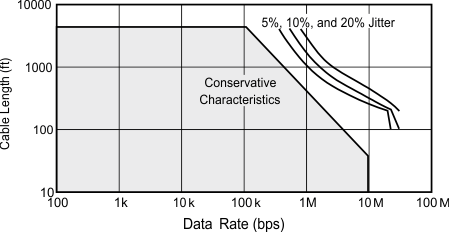SLLSEV1C September 2017 – December 2018 THVD1510 , THVD1512 , THVD1550 , THVD1551 , THVD1552
PRODUCTION DATA.
- 1 Features
- 2 Applications
- 3 Description
- 4 Revision History
- 5 Device Comparison Table
- 6 Pin Configuration and Functions
- 7 Specifications
- 8 Parameter Measurement Information
- 9 Detailed Description
- 10Application and Implementation
- 11Power Supply Recommendations
- 12Layout
- 13Device and Documentation Support
- 14Mechanical, Packaging, and Orderable Information
Package Options
Refer to the PDF data sheet for device specific package drawings
Mechanical Data (Package|Pins)
- D|8
- DGK|8
Thermal pad, mechanical data (Package|Pins)
Orderable Information
10.2.1.1 Data Rate and Bus Length
There is an inverse relationship between data rate and cable length, which means the higher the data rate, the shorter the cable length; and conversely, the lower the data rate, the longer the cable length. While most RS-485 systems use data rates between 10 kbps and 100 kbps, some applications require data rates up to 250 kbps at distances of 4000 feet and longer. Longer distances are possible by allowing for small signal jitter of up to 5 or 10%.
 Figure 24. Cable Length vs Data Rate Characteristic
Figure 24. Cable Length vs Data Rate Characteristic Even higher data rates are achievable (that is, 50 Mbps for the THVD1550, THVD1551 and THVD1552) in cases where the interconnect is short enough (or has suitably low attenuation at signal frequencies) to not degrade the data.